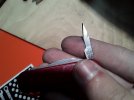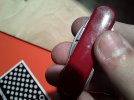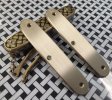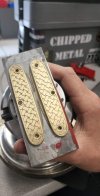This should be my last post about this. Hopefully it will inform and encourage others who are interested in doing this modification, which is converting a Victorinox Waiter to an Apprentice by switching the corkscrew to a phillips driver.
This post is just detailing how the peening process went. There are some previous posts discussing the planning and execution of the pin removal and the preparation of the replacement pin.
I secured the pin in a bench vise sandwiched by cardboard to protect the pin from getting scratched or squished. I then spent around 15-20 minutes tapping the end of the pin with my ball peen hammer to form the first mushroom head.
The pin kept sliding down in the vise. This forced me to keep readjusting it. I was also having some trouble getting the lip of the pin head to form as level. It was sightly tilted horizontally, but I was eventually able to correct it.
It turns out that peening isn't terribly difficult if you use a small hammer, but it does require a lot of patience. I wish I had spent a little more time on the first head to make it bigger, but I was more focused on making sure that the head was level, and so I stopped as soon as the tilt was corrected. I was afraid that the head would become crooked again if I kept tapping it, and I was eager to move on to the next step.
With the first head formed, I inserted the back phillips into the SAK with the knife and combo tool open. With the tools open and out of the way, I was able to close the SAK in the bench vise to compress the spring, which forced the holes to align enough to allow me to insert the pin.
With the pin fully inserted, I released the SAK from the vise, notched the unpeened side of the pin around 1.5-2mm away from the sideplate, and then I cut it with a small hacksaw. I specifically chose to use a hacksaw to carefully preserve as much of the remaining pin as possible so that the leftover piece could potentially be used later for doing the same modification on another Waiter.
Finally, I filed and sanded the trimmed end of the pin to be smooth, and then I began peening it with the other side of the pin resting against a small piece of scrap wood. I probably spent at least an hour on this side. It ended up being much bigger and much thicker than the first head. This actually matches the way Victorinox makes the stock pivot.
Both heads actually ended up looking very nice, which was surprising. I was expecting them to wind up looking like mangled garbage, but I didn't care as long as they would be hidden by the scales. Instead they turned out looking rather good.
I did encounter one small problem. Because I was so paranoid about making the pivot too loose, I accidentally made it just a hair too tight by peening it a little too much. This made the phillips tool lose some of its snap, but this problem miraculously cleared up with a little drop of oil. I'm not even exhaggerating. It was so close to the borderline of over-tightening that it was fixed by one drop of oil. For a first time modification of this kind, this went way better than I expected.
The original scales had been softened with a hot water bath and were gently removed to preserve their fit. As a result, they were able to be reapplied to the knife once the modification was complete.







